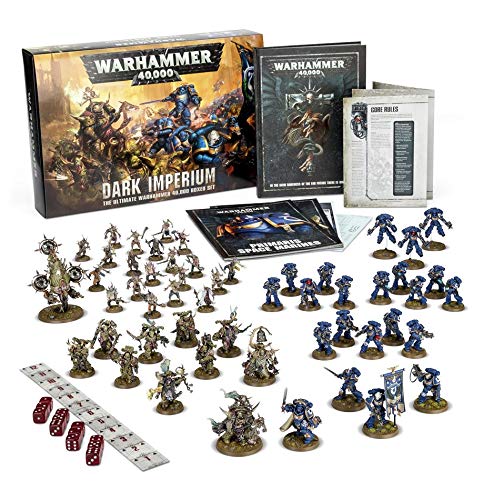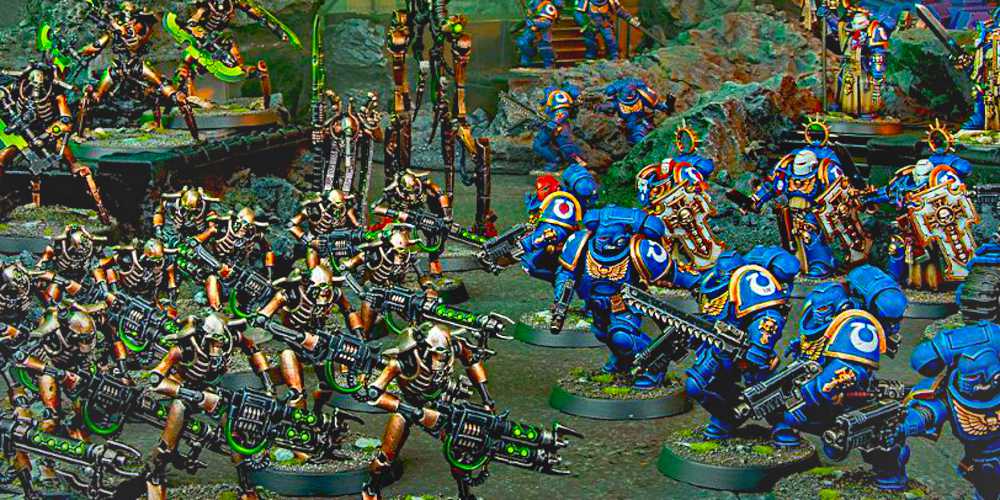Most people know Warhammer as a video game, but aren't aware of its tabletop game roots. If you didn't know already, Warhammer started out as a tabletop game consisting of miniature armies.
There's a lot more to Warhammer 40K than just opening up a box and setting up the game board (which Warhammer 40K doesn't even have).
Not only do you have to learn the rules of the game, but you have to get acquainted with the hobby aspects to Warhammer 40K!
The Lore
Warhammer 40K has an extensive lore that's outlined in the books put together by Games Workshop (Warhammer's creator). Since you probably don't want to pay for the book, I'll give you a quick summary of why there's so much war in Warhammer 40K.
The game takes place in the 41st millennium, a time when humans are no longer the most advanced species on Earth. Aliens bombard Earth with attacks, and only the Space Marines and Adeptus Astartes are powerful enough to hold them off.
Basically, the world of Warhammer 40K is all about defending the Earth from alien invasions.
Basic Warhammer Rules

The rulebook of Warhammer previously consisted of dozens of pages. Thankfully, Games Workshop has condensed it down to a mere eight pages.
Let's be honest, eight whole pages are still excessive, especially if you're used to playing board games like chess or Monopoly.
Just like with Dungeons and Dragons (D&D) and other strategy games, there are a lot of little rules and exceptions that you learn as you go along.
However, when you're just starting to play Warhammer 40K, the most important things to learn are the six different phases of a battle round:
1. Movement Phase
During the movement phase, you can pick one of your units to become mobile. Keep in mind that you'll have several different units that comprise a larger army.
You can move the members of a unit in any direction, as long as the distance doesn't exceed the set amount for that specific model on the character datasheet. All movement is measured in inches, so you'll need to have a tape measure handy.
2. Psychic Phase
The models labeled as a "psyker" on their datasheet can harness psychic powers. You can use these powers, but they come with a risk. Rolling a double one or a double six during the psychic test will mortally wound your psyker.
So, what is a psychic test? It determines whether your psyker gets to utilize the power of your choice.
Rolling two six-sided dice and getting a total that's more or equal than the power's warp charge value means that you can successfully execute an attack.
Otherwise, you'll have to try again during your next turn.
3. Shooting Phase
During the shooting phase, you have to select a unit to shoot with. You can only shoot with models that come equipped with ranged weapons, and they have to be farther than one inch away from your enemy.
After one model in your unit finishes shooting, you can continue shooting with your other models that carry ranged weapons. This goes on until all of these models take a turn shooting.
But before you fire your weapons, you need to figure out who you're going to shoot. You can only shoot enemies that are visible from your model's viewpoint, and the weapon you choose affects how many attacks your model can make.
4. Charge Phase
In the charge phase, your units can throw themselves towards the enemy to attack. The unit you choose during the charge phase has to stand within 12 inches of the enemy. Prior to your charge attack, the enemy gets the chance to retaliate by firing Overwatch.
You'll then have to roll two six-sided dice to see how far your unit can advance. The number on the dice equates to how many inches you can move towards your enemy.
5. Fight Phase
Now here's where things get bloody. Any models (including your opponent's) that have charged or stand within one inch of an enemy can attack during the fight phase.
If some members of your unit are too far from your enemy, you can move them three inches in any direction that points towards your target.
After choosing your target and determining what melee weapon to use, you'll have to figure out how many attacks your model can make using your model's attack characteristic.
6. Morale Phase
After you've completed an exhausting battle, some of your units have fallen. This means that you'll have to take a morale test.
To do this, you need to count every model that has been defeated, roll a dice, and then add the number of fallen models to the number on the dice.
If this number isn't higher than the leadership characteristic in that unit, then you'll have to retire a certain amount of models based on the gap between the two numbers.
Establishing Your Warhammer 40K Army
You'll really enjoy Warhammer 40K if you're into complex strategy games, and enjoy building Gundams. Like I mentioned earlier, Warhammer 40K isn't just game—it's also a collection and a hobby that involves miniatures and painting.
To start playing, you need to choose an army. Each army comes with different looks, abilities, and a story, so choose wisely (or just collect them all).
Some of these armies consist of the Space Marines, Orks, T'au Empire, Adepts Mechanicus, Chaos Daemons, Chaos Space Marines, Necrons, Eldar, Dark Eldar, and more.
You get to put the models together piece-by-piece and even paint them. It's a time-consuming process, but it's worth it when you see your completed army on the table.
Unfortunately, you have to purchase the models that go along with each army, which can get pretty expensive.
Doing the bare minimum in terms of painting will save you a little bit of cash, but the models themselves are still a pricey venture. The Warhammer 40K: Command Edition starter box will give you an idea of how much you'll be spending.
Your Local Warhammer Community
If your friends want nothing to do with Warhammer 40K, don't be discouraged. There are plenty of game communities that you can and should join.
Head to your local board game shop and start asking around—an employee there might have some leads on how to find a Warhammer 40K group. Here are some helpful tips that might come in handy:



